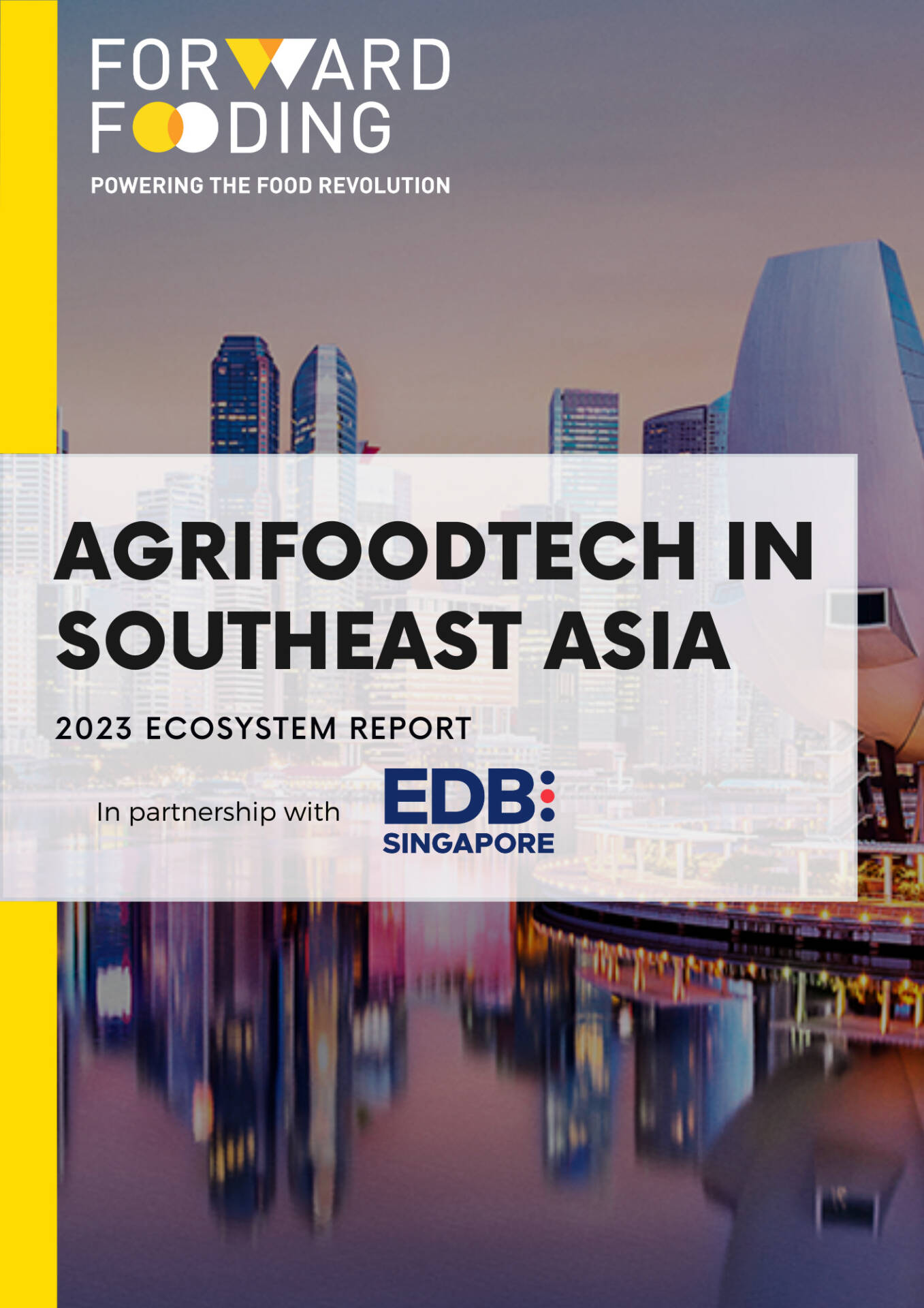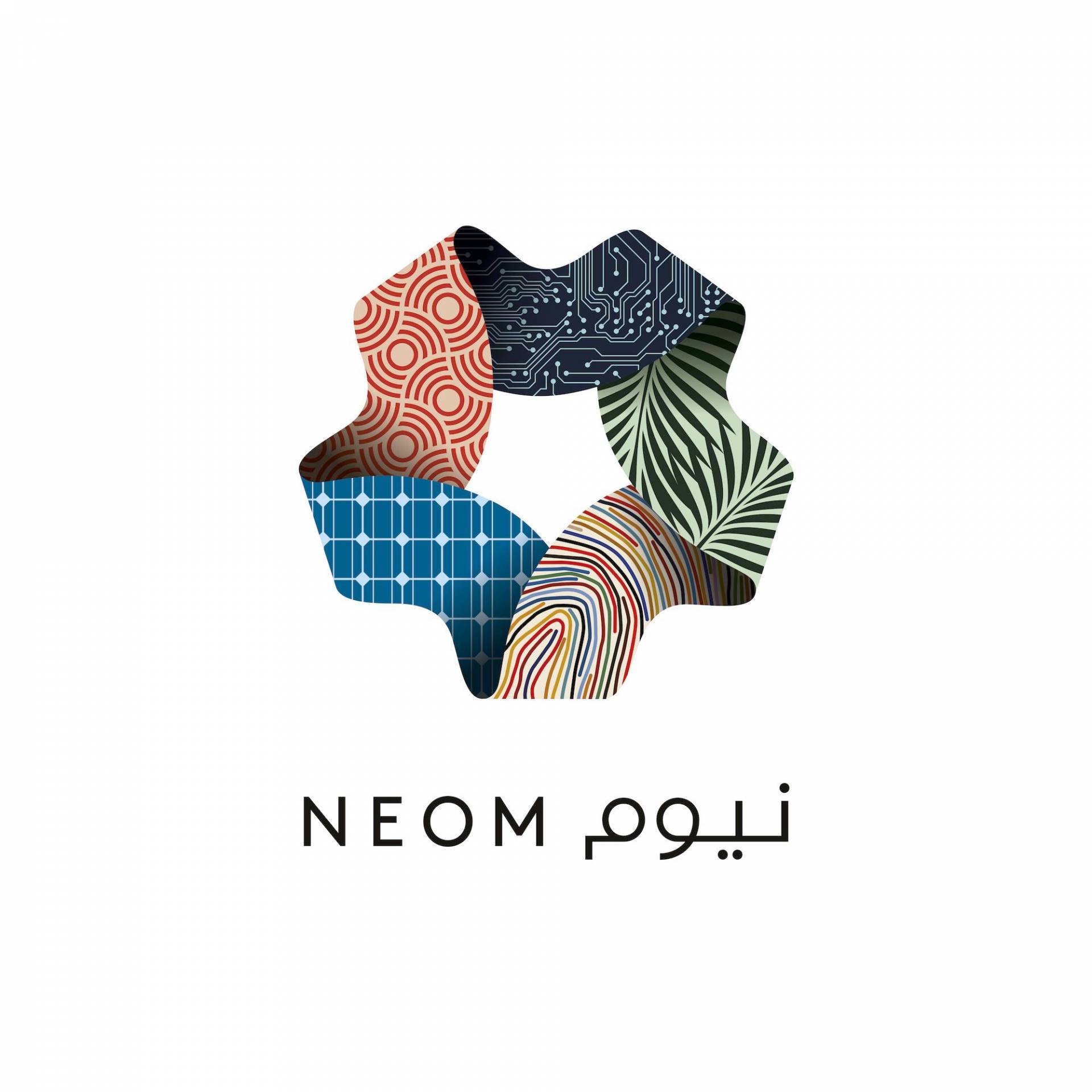FORWARD FOODING
THE BLOG
Smart Irrigation: How High-Tech Watering Systems are Changing Agriculture

Agriculture guzzles up nearly 70-80% of the world’s freshwater. But with climate change and growing water scarcity, traditional irrigation just won’t cut it. Enter smart irrigation—a tech-savvy solution using IoT, AI, and sensors to deliver water precisely when and where it’s needed, supporting sustainable farming and a greener future.
Agriculture has long been a thirsty work, consuming up to 80% of the world’s freshwater. But with water scarcity rising and climate change in full swing, this massive water use isn’t sustainable. Traditional irrigation systems, once the backbone of farming, now seem wasteful and outdated.
Enter smart irrigation, a high-tech solution that isn’t just a buzzword but quickly becoming a must-have in modern farming, driven by converging challenges and opportunities in agriculture. Water scarcity, labor shortages, and rising energy costs are pushing farmers toward innovative solutions, while government incentives make adoption more appealing. The integration of IoT and AI technologies has revolutionized these systems, enabling real-time, data-driven decisions about water usage based on weather, soil conditions, and crop needs. As part of the broader precision agriculture movement, smart irrigation helps farmers optimize resource use and adapt to climate change, delivering water exactly where it’s needed to boost yields while minimizing waste—a critical advancement as agriculture faces increasingly unpredictable weather patterns and the need for greater sustainability.
In the second installment of our Water Tech series, we’ll dive into what smart irrigation is, the technologies behind it, its benefits and challenges, and the impressive companies leading this green revolution.
Precision in Every Drop
Agriculture is in a tight spot: water resources are drying up, climate patterns are shifting, and the world’s population is still growing. Smart irrigation offers a modern, efficient solution by monitoring conditions and adjusting water use in real-time.
Here’s a look at some of the key technologies that make it possible:
- IoT-Based Systems: Internet of Things (IoT) sensors collect data on weather, soil, and air quality, sending it to a cloud platform for analysis. The system then adjusts water flow and irrigation schedules in real-time, maximizing efficiency and reducing waste.
- Artificial Intelligence (AI) or Machine Learning (ML)-Powered Solutions: Analyze historical and real-time data to predict water needs based on weather patterns, soil moisture, and crop requirements.
- Sensor Technologies: Monitor soil moisture, temperature, and nutrient levels, ensuring that crops get exactly what they need.
- Precision Irrigation Systems: Deliver water directly to the roots, reducing evaporation and ensuring minimal waste.
- Weather-Based Controls: Use local weather data to adjust watering schedules so plants get just the right amount of moisture—even on a cloudy day.
The Cost, Concerns, and Complexity Roadblocks
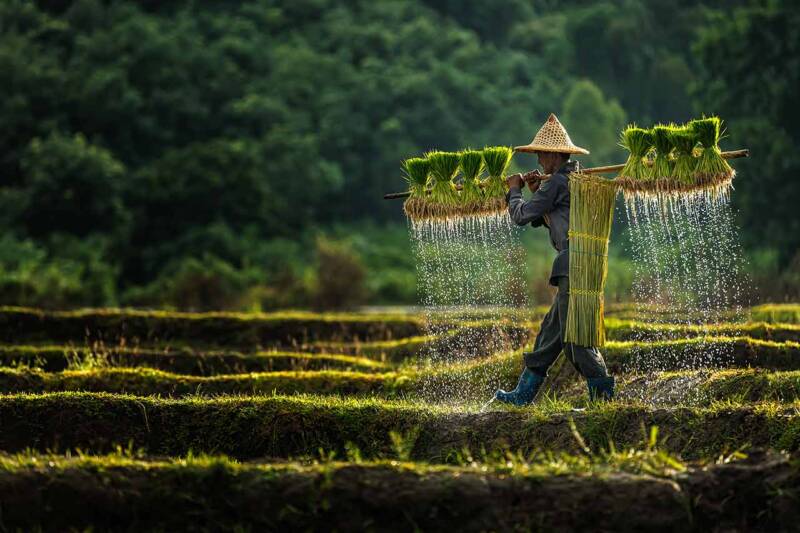
No doubt, smart irrigation has huge potential to transform farming. But like any tech, it’s not without its hurdles. From sky-high upfront costs to connectivity issues, a few key challenges are slowing down the adoption of this water-saving wonder.
The biggest obstacle? Cost. While smart irrigation systems offer advanced, efficient tech, they come with a hefty price tag that’s often hard for smaller farms to justify. Take Smart Watering: its entry-level package, capable of managing up to eight zones, starts at $530, with a $10 monthly subscription for app-based remote access. For many farmers, this combination of tech and price needs careful consideration.
Then there’s the complexity of setup and use. Smart irrigation isn’t exactly plug-and-play; it demands technical know-how from installation to troubleshooting. Many systems even require programming skills, as farmers must configure detailed parameters like soil type and crop needs. Arduino-based controllers, for instance, often need embedded programming skills to run smoothly—adding a layer of difficulty for farmers without tech backgrounds.
Connectivity issues are also a major barrier. Many smart irrigation systems rely on IoT devices that need stable internet, but rural areas, where farms are typically located, often have spotty coverage. Without reliable connectivity, even the most advanced system can’t reach its full potential. A study from South Africa revealed that only 46% of smallholder farmers had adopted climate-smart irrigation, citing limited internet access as a crucial barrier.
Data privacy concerns also loom large. These systems collect a wealth of data—from soil moisture to crop health—but questions around data ownership and access persist. Farmers worry about unauthorized access or misuse of their information by third parties, and unclear legal frameworks only add to these fears, creating another roadblock to adoption.
Compatibility issues further complicate the picture. Integrating smart irrigation with older or traditional farm equipment can be challenging, with 40% of farmers expressing concerns about compatibility in one survey. For farmers, the idea of disruptive integration is a serious deterrent.
And finally, there’s the matter of ROI. Farmers want to see tangible, quick returns on their investments, but the benefits of smart irrigation aren’t always immediate. Typical ROI for sensor-based systems falls between 1.5 and 2 years, during which farmers may see up to a 40% yield increase and a 50% reduction in water use—plus labor cost savings. Still, without upfront evidence of cost savings, many farmers hesitate to take the plunge.
The Eco-Payoff
Smart irrigation isn’t just good for farmers, it’s also great for the planet. This tech is making a real difference in sustainability, from conserving water to reducing carbon footprints. Here’s how smart irrigation is driving eco-friendly practices and building a greener future:
- Smart irrigation systems can cut water use by 40% to over 70%, depending on the setup and conditions. That’s a huge win in water-stressed areas.
- By reducing the need for pumping and distribution, smart irrigation also saves energy. In fact, some IoT-based systems have slashed energy use by up to 30%.
- Efficient water management prevents soil degradation, erosion, and nutrient loss. Smart irrigation helps keep soil structure and nutrients intact, supporting sustainable agriculture.
- By reducing runoff, these systems prevent harmful pollutants like nitrates from seeping into groundwater, protecting local ecosystems from contamination.
- Using less water and energy means fewer greenhouse gases. For example, Lowe’s saved 650 million gallons of water annually with smart irrigation, cutting 750 metric tons of CO2 emissions.
The New Crop of Startups
The smart irrigation market is on a rapid rise, valued at around $1.8 billion in 2024 and projected to hit $3 billion by 2029, fueled by a strong 11.2% annual growth rate. This boom is powered by increased government initiatives promoting water conservation and ongoing drops in the cost of essential components like controllers and sensors—making smart irrigation more affordable and attractive for wider adoption.
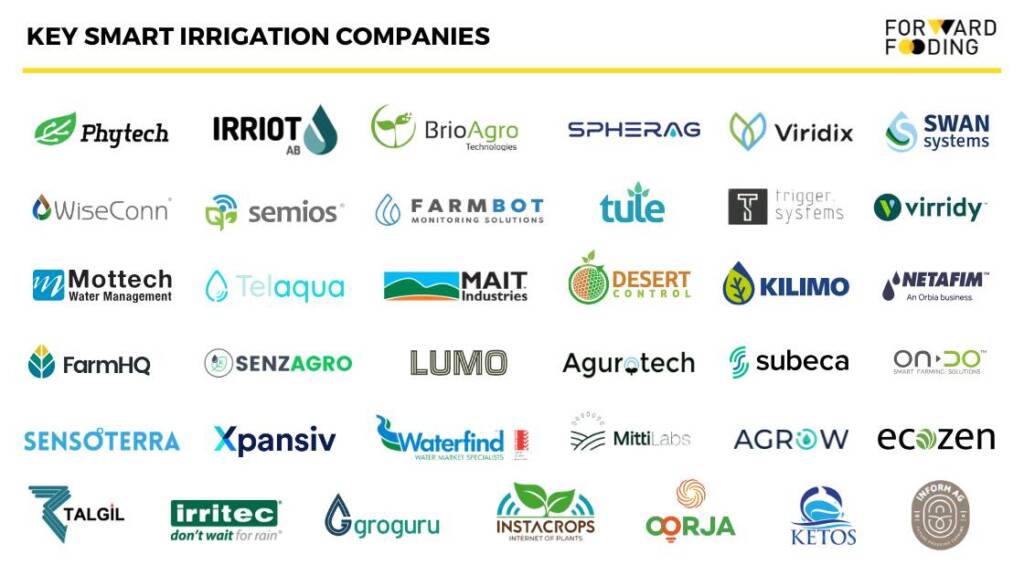
Disclaimer: This list of companies is not exhaustive and only features certain products for demoing purposes – the full list is available via the FoodTech Data Navigator.
Here are some of the companies leading the charge in transforming the industry:
- Phytech (Israel): helps more than 900 of the world’s largest growers optimize their production by enabling them to monitor, plan, and control their operations with an end-to-end Farming Operating System
- SPHERAG (Spain): offers a unique combination of IoT and cloud services that enable remote access without the need for prior connectivity or cabling deployment, thanks to its solar power capabilities
- Irriot (Sweden): provides a wireless precision irrigation automation system that utilizes the latest radio technology, multiple sensors, and a cloud platform
- BrioAgro Tech (Spain): offers a system that also provides alerts for farm breakdowns and issues like pipe failures and diseases
- SWAN Systems (Australia): a water and fertilizer management platform that enables irrigators to improve yields and increase profits whilst meeting sustainability outcomes
- FarmBot (Australia): offers solutions designed to withstand remote connectivity constraints
- Instacrops (Chile): a virtual assistant that combines high-power Software and IoT modules to optimize irrigation, provide weather forecasts, detect pests and diseases, and maximize fertilizers
- Viridix (Israel): a platform that combines RooTense® sensors, AI analytics, and real-time monitoring to provide actionable insights and enable autonomous irrigation
- Semios (Canada): a crop management platform helping growers respond to disease, pest, water, and climate risk in real-time
- Wiseconn (US): provides a user-friendly system for easy monitoring and control, offering farmers the most complete irrigation management system available
- Netafim (Israel): the world’s largest irrigation company that’s leading the way in digital farming, irrigation, and fertigation, integrating real-time monitoring, analysis, and automated control into one state-of-the-art system
- Irritec (Italy): designs, manufactures and distributes products and complete systems for irrigation in open fields, in greenhouses and for the ladscape sector
- MAIT Industries (Australia): provides innovative monitoring and irrigation control solutions that assist growers, horticulturists, turf managers, and other water users and providers to improve their water management practices
- Talgil (Israel): develops, produces, markets, and provides professional irrigation control systems for Open field, Greenhouse, Municipal, and Residential applications
- Mottech Water Management (Israel): provides comprehensive, professional irrigation, and water control management systems for Agricultural Irrigation, Municipal Turf & Landscape Irrigation, and Water Distribution applications
- GroGuru (US): deploys permanent soil sensors that measure soil moisture, temperature, and salinity at various root depths to recommend when and how much to irrigate crops
- KETOS (US): offers hardware and software analytics solutions that monitor various water health parameters such as pH, dissolved solids, hardness, turbidity, and salinity
- Telaqua (France): offers a platform that utilizes sensors and a mobile application to provide real-time data on water usage and plant health
- Lumo (US): an all-in-one precision irrigation system with patented hardware, intuitive software, and a local field team providing hands-on support
- FarmHQ (US): a cellular-connected device that can be added to any irrigation pump for real-time monitoring, automation, and detection of equipment failures
- Subeca (US): an innovative company offering an end-to-end water management platform to provide 24/7 utility control
- Trigger.Systems (Portugal): developed a system that incorporates computer vision intelligence to detect events and gather relevant information for decision-making
- SenzAgro Solutions (Sri Lanka): makes affordable, tailor-fit climate-smart agriculture technologies accessible to farmers in the APAC region
- ONDO Solutions (Bulgaria): offers a monthly subscription-based model for their advanced farming solutions
- Kilimo (Argentina): features climate monitoring by using satellite and site data to provide prescriptions for each crop
- Sensoterra (Netherlands): offers sensors that enable a reduction in water use of up to 30% and are compatible with all soil types
- Agrow (Spain): provides a platform to monitor in real-time and future predictions of water availability in the terrains and its effect on the crops.
- MittiLabs (India): centralizes irrigation data and receives precise, data-driven recommendations on where, when, and how much to irrigate to optimize water usage and crop health.
- H2Ox (Australia): provides a state-of-the-art technology platform for the electronic trading of water entitlements and allocations
- Oorja (India): offers Farming as a Service, providing solar-powered irrigation, milling, and cooling solutions to off-grid rural communities
- WaterFind (Australia): facilitates the buying and selling of permanent and temporary water across major irrigation districts
- Ecozen (India): offers Ecotron, a leading solar pump solution that embeds IoT & efficient motor technology to provide the most efficient irrigation solution for farmers, along with remote monitoring, diagnostics, and predictive analytics
- Virridy (US): develops and deploys technologies to manage water, energy, and agricultural resources in remote, off-grid environments
- Inform AG (Australia): offers services that include whole-farm control, monitoring, and automation systems, which encompass robotic machinery and orchard irrigation.
- Agurotech (Netherlands): offers products that include robust and highly reliable sensing technology, tailored irrigation recommendations, and continuous improvement of the irrigation process.
- Tule (US): developed an app called Tule Vision, which allows grape growers to take midday Leaf Water Potential readings using their smartphone camera
- Desert Control (Norway): uses its patented Liquid NanoClay to transform deserts into fertile land in just 7 hours
- CropX (US): one of the top irrigation management solutions that provides insights and advice on irrigation activities for more precise water applications
Case Studies and Success Stories
CASE STUDY #1: N-DRIP
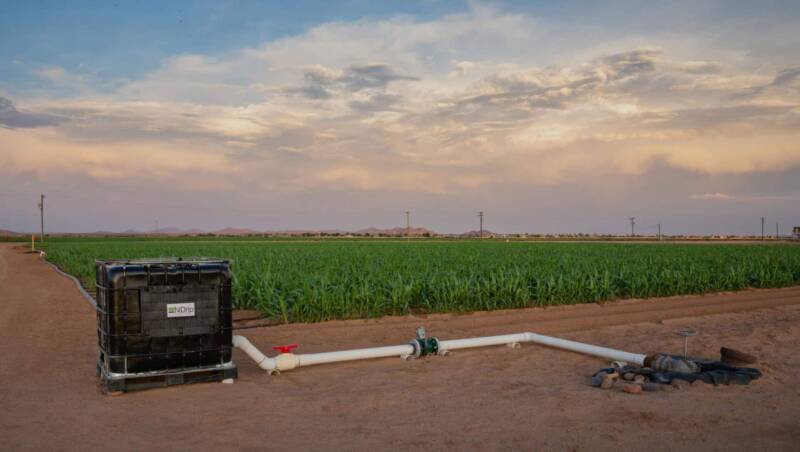
Focus: Affordable, water-efficient irrigation in arid climates
N-Drip is transforming irrigation with its gravity micro-irrigation systems, allowing farmers to water their crops precisely without the need for expensive pumps or filters. In water-scarce regions, N-Drip’s low-pressure solution has cut water use by up to 26% and boosted yields by 47%. Their mission? To replace wasteful flood irrigation with efficient, eco-friendly technology.
Key Features:
- No need for pumps or filters
- Adaptability to low-pressure conditions
- Significantly lower water consumption than traditional irrigation
CASE STUDY #2: CROPX
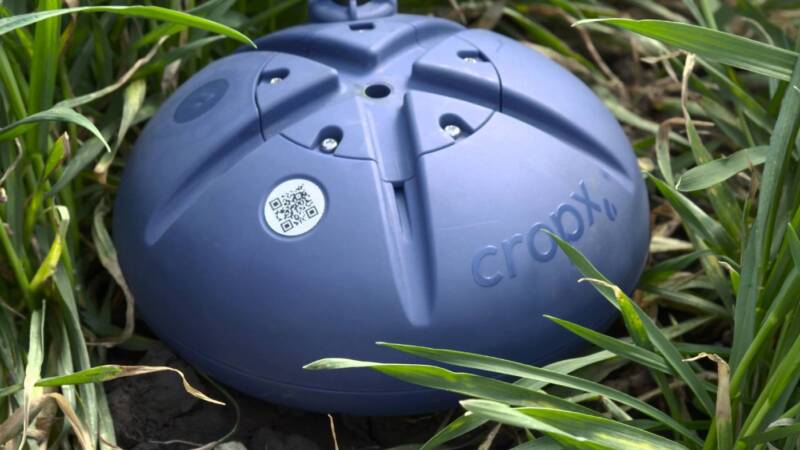
Focus: Leverages soil sensors and data analytics to optimize irrigation and conserve water resources
CropX is making waves in sustainable farming with advanced soil monitoring systems that enable precise irrigation management. Their tech has delivered over 40% water savings across various crops while increasing yields by around 10%, proving that efficient resource use and productivity can go hand in hand.
Key Features:
- Real-time soil moisture monitoring
- Adaptive irrigation schedules
- Significant water savings
CASE STUDY #3: SUNCULTURE
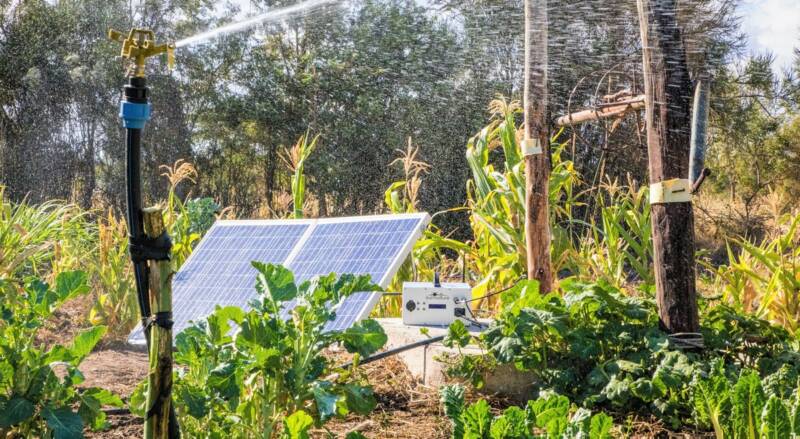
Focus: Enhances agricultural productivity for smallholder farmers across Africa
SunCulture empowers smallholder farmers with solar-powered irrigation, boosting crop yields by 2-5 times and reducing dependence on costly diesel pumps. Their “Pay-As-You-Grow” model makes the tech affordable, enhancing food security and economic stability for rural communities.
Key Features:
- Solar energy for off-grid use
- Targeted for smallholder farmers
- Increased productivity and income potential
CASE STUDY #4: HORTAU

Focus: A strong market presence by enhancing crop health and resource efficiency
A veteran in smart irrigation, Hortau uses sensor-based tech to track soil tension and water stress, helping North American farmers optimize water use and improve crop health. Their longstanding reputation underscores their dedication to water efficiency and sustainable farming practices.
Key Features:
- In-depth soil tension analysis
- Water stress alerts
- Extensive market experience
Looking Ahead: The Future of Smart Irrigation
Smart irrigation isn’t just a tech upgrade; it’s a game-changer for agriculture. By saving water, reducing energy use, and supporting sustainable farming, these systems could be the answer to some of agriculture’s biggest challenges. The road to widespread adoption might be bumpy, with costs and connectivity issues to tackle, but the benefits make it worth the investment. As we face a future where every drop counts, smart irrigation stands ready to keep our fields green and our resources protected.
Learn more about our Taxonomy in our Activity Spotlight for AgTech.
Forward Fooding is the world’s first collaborative platform for the Food & Beverage industry via FoodTech Data Intelligence and Corporate-Startup Collaboration – Learn more about our Consultancy and Scouting Services and our Startup Network.
Follow us
Sponsored Articles
9 July 2025
Forward Fooding celebrates the selection of 12 pioneering startups for the inaugural pladis Accelerator Programme. From water lily popcorn to sugar-converting enzymes, these innovations represent the future of snacking, addressing obesity, sustainability, and personalized nutrition through cutting-edge food technology.
21 March 2025
Tim Ingmire, VP of Global Innovation & Technology at pladis, discusses how the snacking giant is supporting early-stage startups in foodtech, health, and sustainability through their accelerator program. Learn about their focus on personalized nutrition, functional foods, and future ingredients to bring innovative, delicious products to consumers worldwide.
8 February 2024
Future Food-Tech returns to San Francisco on March 21-22 Over 1,700 food-tech leaders, from CPG brands, retailers, ingredient providers, [...]
1 February 2023
The 4th edition of FoodTech 500 is taking off and we are excited to partner with NEOM for the third consecutive year to support the best international AgriFoodTech entrepreneurs.
10 February 2022
One of the elements we enjoy the most here at Forward Fooding about working with AgriFoodTech startups is being [...]
